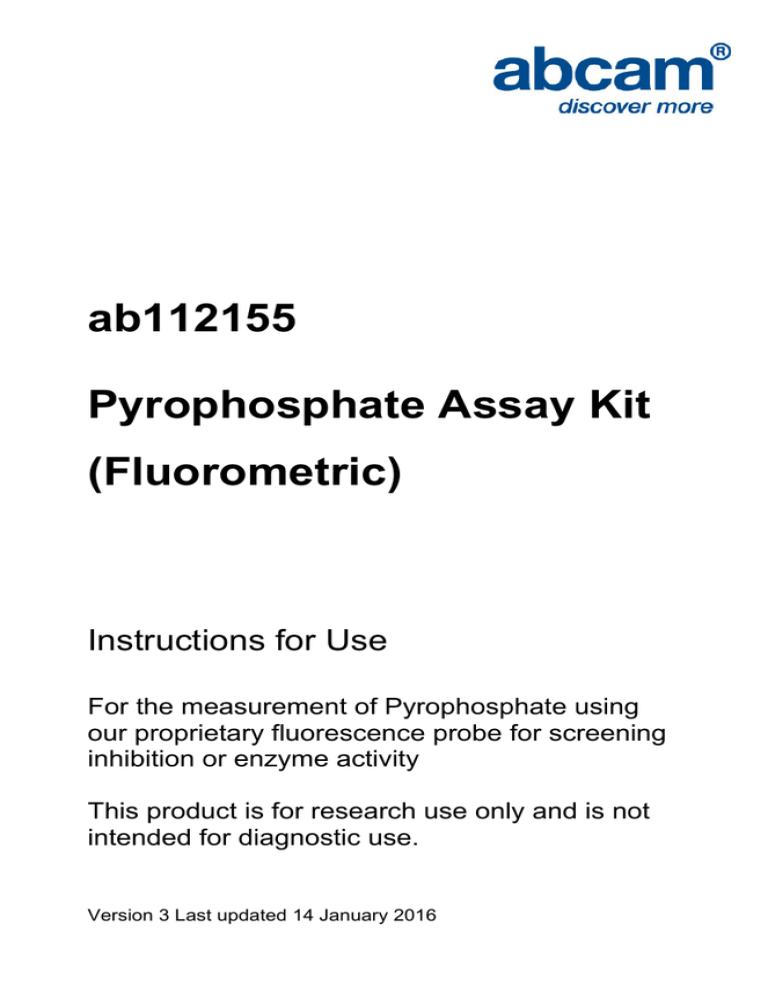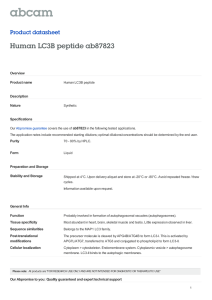
ab112155
Pyrophosphate Assay Kit
(Fluorometric)
Instructions for Use
For the measurement of Pyrophosphate using
our proprietary fluorescence probe for screening
inhibition or enzyme activity
This product is for research use only and is not
intended for diagnostic use.
Version 3 Last updated 14 January 2016
1
Table of Contents
1.
Introduction
3
2.
Protocol Summary
5
3.
Kit Contents
6
4.
Storage and Handling
6
5.
Assay Protocol
7
6.
Data Analysis
11
7.
Troubleshooting
12
2
1. Introduction
Pyrophosphate (PPi) are produced by a number of biochemical
reactions, such as ATP hydrolysis, DNA and RNA polymerizations,
cyclic AMP formation by the enzyme adenylate cyclase and the
enzymatic activation of fatty acids to form their coenzyme A esters.
ab112155 provides the most robust spectrophotometric method for
the measurement of pyrophosphate. It uses our proprietary
fluorogenic pyrophosphate sensor that has its fluorescence intensity
proportionally dependent upon the concentration of pyrophosphate.
Our assay is much easier and more robust than enzyme-coupling
pyrophosphate methods, which require at least two enzymes for their
pyrophosphate detections. Due to its direct measurement of
pyrophosphate, this kit is ideal for screening inhibition or activities of
enzymes that consume or generate pyrophosphate.
ab112155 is an optimized mix-and-read assay and can be performed
in a convenient 96-well or 384-well microtiter-plate format. The kit
provides all the essential components for assaying pyrophosphate.
3
Kit Key Features
Universal: Can be used to monitor any biological processes
that generate pyrophosphate.
Continuous: Easily adapted to automation without mixing or
separation.
Convenient: Formulated to have minimal hands-on time.
Non-Radioactive: No special requirements for waste
treatment
4
2. Protocol Summary
Summary for One 96-well Plate
Prepare pyrophosphate standards (50 μL) and/or test
samples (50 μL)
Add Assay solution (50 μL)
Incubate at room temperature for 10-30 minutes
Monitor fluorescence intensity at
Ex/Em = 316/456 nm
Note: Thaw all the kit components to room temperature before
starting the experiment.
5
3. Kit Contents
Components
Component A: Assay Buffer
Amount
1 x 25 mL
Component B: PPi Sensor (Lyophilized)
1 vial
Component C: 50 mM Pyrophosphate Standard
1 mL
Component D: DMSO
1 x 200 µL
4. Storage and Handling
Keep at -20°C. Avoid exposure to light.
6
5. Assay Protocol
Note: This protocol is for one 96 - well plate.
A. Preparation of Assay Solutions
1. Thaw all the four components at room temperature
before use.
2. Prepare 200X PPi Sensor Stock Solution: Add 50 µL of
DMSO (Component D) into the vial of PPi Sensor
(Component B) to make 200X PPi Sensor Stock
Solution.
Note: 25 µL of the PPi Sensor Stock Solution is enough
for one 96-well plate. The unused PPi Sensor Stock
Solution should be divided into single-use aliquots. Store
at -20 °C and protect from light.
3. Prepare Assay Solution: Add 25 µL of 200X PPi Sensor
Stock Solution (from Step A.2) to 5 mL of Assay Buffer
(Component A), and mix them well.
Note: Due to the high sensitivity of this assay to PPi, it is
important to use PPi-free labware and reagents.
7
B. Preparation of Pyrophosphate Standards and Test
Samples
1. Prepare 1 mM Pyrophosphate Standard Solution: Add
10 μL of 50 mM Pyrophosphate Standard (Component
C) into 490 μL of Assay Buffer (Component A), or buffer
of your choice (preferably 50 mM Hepes buffer, pH 7) to
make 1 mM pyrophosphate standard solution.
2. Add 50 μL of 1 mM pyrophosphate standard solution
(from Step 2.1) into 450 μL of Assay Buffer (Component
A) to get 100 μM pyrophosphate standard solution, and
then take 200 μL of 100 μM pyrophosphate standard
solution to perform 1:3 serial dilutions to get 30, 10, 3, 1,
0.3, 0.1 and 0 μM serially diluted pyrophosphate
standards.
3. Add serially diluted pyrophosphate standards and/or
pyrophosphate-containing test samples into a solid black
96-well microplate as described in Tables 1 and 2.
4.
Urine, serum and plasma samples should be diluted in
a range of 1/250 -1/5000.
8
BL
BL
TS
TS .....
PS1
PS1
....
....
PS2
PS2
....
....
PS3
PS3
PS4
PS4
PS5
PS5
PS6
PS6
PS7
PS7
Table 1 Layout of pyrophosphate standards and test
samples in a solid black 96-well microplate.
Note: PS = Pyrophosphate Standard, BL = Blank Control,
TS = Test Sample
Pyrophosphate
Standard
Blank Control
Serial dilutions*:
Assay Buffer:
50 μL
50 μL
Test Sample
50 μL
Table 2. Reagent composition for each well.
*Note: Add serially diluted pyrophosphate standards from
0.3 μM to 100 μM into wells from PS1 to PS7.
9
C. Run Pyrophosphate Assay:
1. Add 50 μL/well of Assay Solution (from Step A.3) to the
wells of pyrophosphate standards, blank control, and
test samples. Mix the reagents thoroughly.
Note: For a 384-well plate, add 25 μL of sample and
25 μL of Assay Solution into each well.
2. Incubate at room temperature for 10 to 30 minutes.
3. Measure fluorescence in a microplate reader at Ex/Em
316/456 nm.
10
6. Data Analysis
The fluorescence in blank wells (with the assay buffer only) is used
as a control, and is subtracted from the values for those wells with
pyrophosphate reactions. A pyrophosphate standard curve is shown
in Figure 1.
Note: The fluorescence background increases with time, thus it is
important to subtract the fluorescence intensity value of the blank
wells for each data point.
Figure 1. Pyrophosphate, ATP and phosphate dose responses were
measured with ab112155 in a solid black 96-well plate using a
fluorescence microplate reader. As low as 1 μM (100 picomoles/well)
pyrophosphate can be detected with 10 minutes incubation.
11
7. Troubleshooting
Problem
Reason
Solution
Assay not
working
Assay buffer at
wrong temperature
Assay buffer must not be chilled
- needs to be at RT
Protocol step missed
Plate read at
incorrect wavelength
Unsuitable microtiter
plate for assay
Unexpected
results
Re-read and follow the protocol
exactly
Ensure you are using
appropriate reader and filter
settings (refer to datasheet)
Fluorescence: Black plates
(clear bottoms);
Luminescence: White plates;
Colorimetry: Clear plates.
If critical, datasheet will indicate
whether to use flat- or U-shaped
wells
Measured at wrong
wavelength
Use appropriate reader and filter
settings described in datasheet
Samples contain
impeding substances
Unsuitable sample
type
Sample readings are
outside linear range
Troubleshoot and also consider
deproteinizing samples
Use recommended samples
types as listed on the datasheet
Concentrate/ dilute samples to
be in linear range
12
Problem
Reason
Solution
Samples
with
inconsistent
readings
Unsuitable sample
type
Refer to datasheet for details
about incompatible samples
Use the assay buffer provided
(or refer to datasheet for
instructions)
Use the 10kDa spin column
(ab93349) or Deproteinizing
sample preparation kit
(ab93299)
Increase sonication time/
number of strokes with the
Dounce homogenizer
Aliquot samples to reduce the
number of freeze-thaw cycles
Troubleshoot and also consider
deproteinizing samples
Use freshly made samples and
store at recommended
temperature until use
Wait for components to thaw
completely and gently mix prior
use
Always check expiry date and
store kit components as
recommended on the datasheet
Samples prepared in
the wrong buffer
Samples not
deproteinized (if
indicated on
datasheet)
Cell/ tissue samples
not sufficiently
homogenized
Too many freezethaw cycles
Samples contain
impeding substances
Samples are too old
or incorrectly stored
Lower/
Higher
readings in
samples
and
standards
Not fully thawed kit
components
Out-of-date kit or
incorrectly stored
reagents
Reagents sitting for
extended periods on
ice
Incorrect incubation
time/ temperature
Incorrect amounts
used
Try to prepare a fresh reaction
mix prior to each use
Refer to datasheet for
recommended incubation time
and/ or temperature
Check pipette is calibrated
correctly (always use smallest
volume pipette that can pipette
entire volume)
13
Standard
curve is not
linear
Not fully thawed kit
components
Pipetting errors when
setting up the
standard curve
Incorrect pipetting
when preparing the
reaction mix
Air bubbles in wells
Concentration of
standard stock
incorrect
Errors in standard
curve calculations
Use of other
reagents than those
provided with the kit
Wait for components to thaw
completely and gently mix prior
use
Try not to pipette too small
volumes
Always prepare a master mix
Air bubbles will interfere with
readings; try to avoid producing
air bubbles and always remove
bubbles prior to reading plates
Recheck datasheet for
recommended concentrations of
standard stocks
Refer to datasheet and re-check
the calculations
Use fresh components from the
same kit
For further technical questions please do not hesitate to
contact us by email (technical@abcam.com) or phone (select
“contact us” on www.abcam.com for the phone number for
your region).
14
UK, EU and ROW
Email:
technical@abcam.com
Tel: +44 (0)1223 696000
www.abcam.com
US, Canada and Latin America
Email: us.technical@abcam.com
Tel: 888-77-ABCAM (22226)
www.abcam.com
China and Asia Pacific
Email: hk.technical@abcam.com
Tel: 108008523689 (中國聯通)
www.abcam.cn
Japan
Email: technical@abcam.co.jp
Tel: +81-(0)3-6231-0940
www.abcam.co.jp
15
Copyright © 2012 Abcam, All Rights Reserved. The Abcam logo is a registered trademark.
All information / detail is correct at time of going to print.

![Anti-DR4 antibody [B-N28] ab59481 Product datasheet Overview Product name](http://s2.studylib.net/store/data/012243732_1-814f8e7937583497bf6c17c5045207f8-300x300.png)
![Anti-FAT antibody [Fat1-3D7/1] ab14381 Product datasheet Overview Product name](http://s2.studylib.net/store/data/012096519_1-dc4c5ceaa7bf942624e70004842e84cc-300x300.png)



